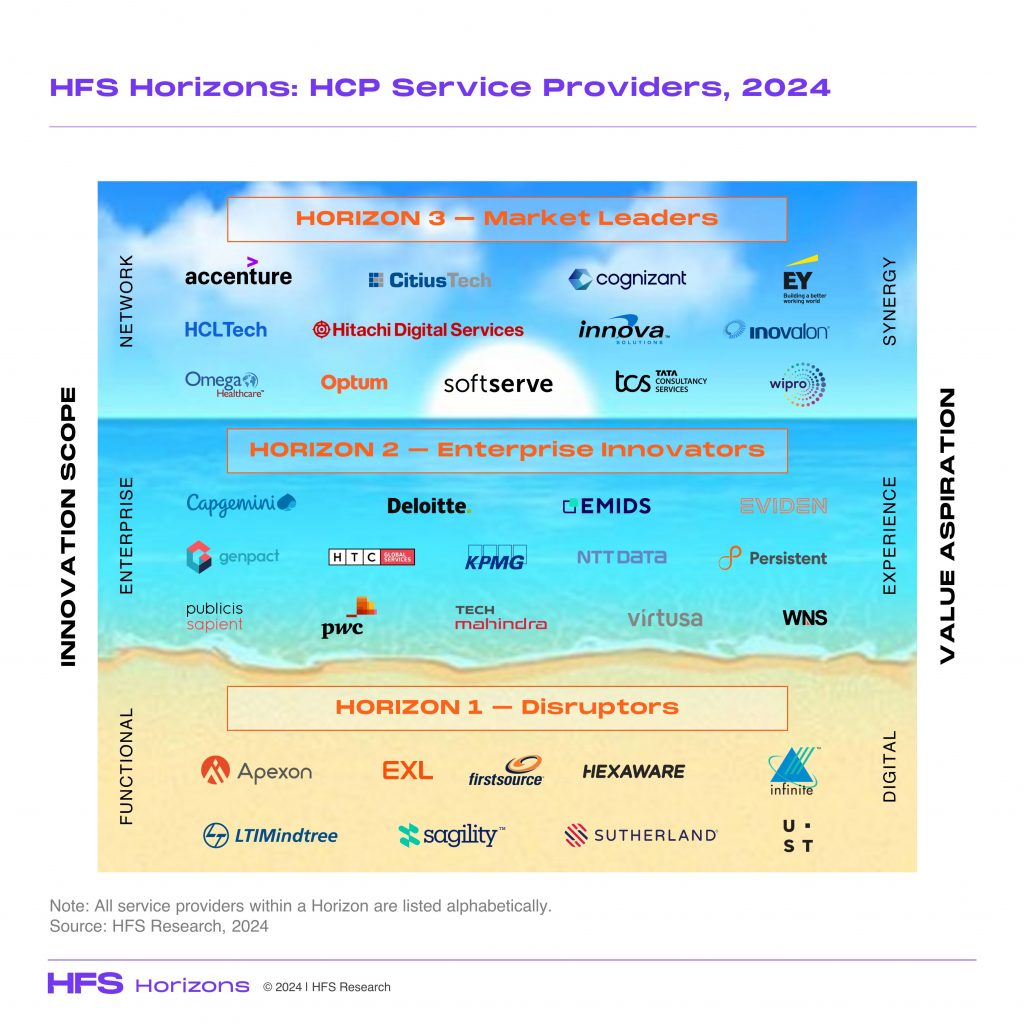There has been much progress with life expectancies, health outcomes, and access to care across the globe—although it is inconsistent. Therefore, it should be unsurprising that the triple aim of care (cost, experience, and health outcomes) remains elusive in the US and worldwide. Still, the post-pandemic years have seen significant progress in applying technologies smartly and an attitudinal shift to experiment in a regulated industry.
In the HFS Horizons: Healthcare Providers (HCP) Service Providers, 2024 study, we evaluated 36 service providers for their ability to address the cost (Horizon 1), experience (Horizon 2), and health outcomes (Horizon 3) for health consumers globally.
Exhibit 1: The increasing number of service providers capable of addressing the triple aim of care is reflected in the large cohort of Horizon 3 placements
Financial pressures take center stage for health systems and hospitals
The end of the pandemic-driven stimulus has returned healthcare providers to a new reality with even greater pressure to remain above water financially. Given the deteriorating health outcomes in the US and other large population centers, demand for care is increasing. This is why providers must discover a way to meet the demand in a cost-optimum manner.
The desire to improve the point-of-care experience and drive connectivity in a post-care scenario is growing to drive retention and value-based care (VBC) outcomes. Providers are becoming more open to technology-enabled innovation to improve productivity, health outcomes, and financial woes.
Lastly, there has been a material increase in outsourcing and offshoring for services and technology enablement, an acceleration over the past few years driven by the need of the hour and the supplier landscape.
Service provider capabilities and attitudes shift toward the possibilities
Service providers have improved their ability to address complex clinical and financial challenges by attracting talent from the industry, investing in key technologies, and becoming bolder in their market approach. Many service providers have significantly expanded their delivery footprint across the globe, addressing new markets and solving distinctly local problems.
The sophistication of capabilities leveraging technology to predict a pneumothorax, prevent diabetes, or facilitate food as a prescription adds an incredible new lever in the marketplace to help health systems and hospitals fight diseases.
Despite progress, opportunities continue to be missed to address the triple aim of care
While many service providers have the capabilities to address all attributes of the triple aim of care and have ample evidence to showcase results, health systems and hospitals remain entrenched in the legacy paradigm of addressing episodic symptoms rather than holistic health.
The bias toward acute care has translated into ignoring and underserving primary care, post-acute care, and rehab (physical therapy, substance abuse treatment). Technology adoption in the non-acute care space for electronic health records and revenue cycle management is below 50%, indicating a huge opportunity to remediate and support basic healthcare.
The Bottom Line: Those who help save lives need help keeping their businesses alive so they can positively and consistently impact the triple aim of care.
As the US and world population ages rapidly, climate change’s implications for health become acute, and clinician shortages are exacerbated, implementing creative ecosystems and improving how we address health and deliver care equitably has never been more urgent. The contemporary paradigm is a legacy sick-care construct ill-suited to the 21st century. We all need to lean in to reimagine and do it fast to move the triple-aim needle.
HFS subscribers can download the report here.
Posted in : Healthcare, Healthcare and Outsourcing, HFS Horizons, Life Sciences






